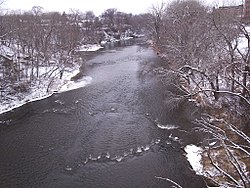Eau Claire River (Chippewa River tributary)

The Eau Claire River is a tributary of the Chippewa River in west-central Wisconsin in the United States.[1] It is one of three rivers by this name in Wisconsin. Via the Chippewa River, it is part of the Mississippi River watershed. Its name is the French translation from the Ojibwe Wayaa-gonaatigweyaa-ziibi (Clear potable-water River).
Course

The Eau Claire River rises as two streams, the North Fork Eau Claire River and the South Fork Eau Claire River, both of which rise in southwestern Taylor County and flow generally southwestwardly through northeastern Clark and northwestern Eau Claire Counties. The North Fork is about 25 mi (40 km) long and flows past the village of Lublin; it collects the Wolf River in Eau Claire County. The South Fork is about 35 mi (56 km) long.

From the convergence of its headwaters' forks, the Eau Claire River flows generally westwardly through northern Eau Claire County for about 40 mi (64 km), past the city of Altoona to its confluence with the Chippewa River in downtown Eau Claire. Two dams along its course in Eau Claire County cause the river to form two reservoirs: Lake Eau Claire and Lake Altoona. Upstream from Altoona, just north of the village of Fall Creek, the river passes over a waterfall known as Big Falls, which is the site of a county park.
Cultural information
Eau Claire River (named the "Clear Water River, a branch of the Chippewa") serves in part as the boundary between the Chippewa and Winnebago in an 1825 treaty,[2] and as a southern boundary for the 1837 Treaty-ceded Territory, where the signatory Ojibwe Bands may hunt, fish and gather to maintain their cultural livelihood.
See also
References
- ^ U.S. Geological Survey Geographic Names Information System: Eau Claire River (Chippewa River tributary)
- ^ "Treaty with The Sioux etc - 1825". www.firstpeople.us. Archived from the original on 12 June 2020. Retrieved 12 June 2020.
External links
- Big Falls County Park website
- Columbia Gazetteer of North America - river length information
